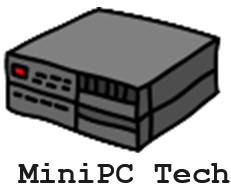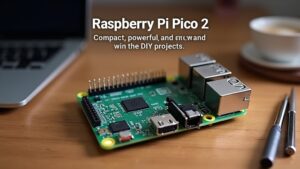The Raspberry Pi Pico 2 impresses with significant performance upgrades and versatile features perfect for your projects. With dual-core processing at 150 MHz, it outperforms its predecessor, allowing for complex tasks and multitasking with ease. You’ll appreciate the 520 KB SRAM and 4 MB flash memory for ample storage. Its GPIO configuration and various communication protocols—like UART and SPI—open numerous interfacing possibilities. Security features, including the Arm TrustZone architecture, enhance its robustness. This compact, compatible design makes it ideal for everything from educational purposes to innovative IoT applications. Explore further to uncover what makes this device a standout choice!
Note: there are affiliate links in this post. As an Amazon Affiliate, I might make a small commission on every purchase. No extra charge to you and it helps to support this blog.
Key Takeaways
- The Raspberry Pi Pico 2 features a dual-core architecture, significantly boosting performance with processing power nearly double that of the original RP2040.
- It boasts 520 KB SRAM and 4 MB QSPI flash storage, enhancing memory capabilities for complex, multitasking applications.
- The design retains the compact size and mechanical compatibility of its predecessor, facilitating easy integration into various projects.
- Security is a priority, offering features like Arm TrustZone architecture and a signed boot mechanism for protecting against unauthorized firmware execution.
- With extensive GPIO options and support for multiple communication protocols, the Pico 2 is versatile for IoT, robotics, and educational projects.
Options for Buying the Raspberry Pico 2
- Dual Arm Cortex-M33 or dual RISC-V Hazard3 processors @ 150MHz CPU
- 520 KB on-chip SRAM; 4 MB on-board QSPI flash
- 2 × UART, 2 × SPI controllers, 2 × I2C controllers, 24 × PWM channels, 1 × USB 1.1 controller and PHY, with host and device support, 12 × PIO state machines
- There are several options for this item, this option is Starter Kit, Please click the image2 to check the package content.
- RP2350 microcontroller chip designed by Raspberry Pi in the United Kingdom. Adopts unique dual-core and dual-architecture design: dual-core Arm Cortex-M33 processor and dual-core Hazard3 RISC-V...
- 520KB of SRAM, and 4MB of on-board Flash memory. Castellated module allows soldering direct to carrier boards
Hardware Specifications
When it comes to hardware specifications, the Raspberry Pi Pico 2 impresses with its dual-core architecture, offering the flexibility of both Arm Cortex-M33 and RISC-V Hazard3 processors. This architecture lets you switch between cores, allowing you to optimize performance based on your project requirements.
Operating at frequencies of up to 150 MHz, it handles demanding tasks while maintaining power efficiency, essential for applications involving sensor integration. The Pico 2 features Wi-Fi connectivity, addressing a previous limitation, which enhances its capabilities for remote applications. Additionally, it utilizes the RP235x microcontroller chip, providing enhanced ARM cores with improved clock speed and memory.
The Pico 2 is equipped with 520 KB of on-chip SRAM and 4 MB of QSPI flash storage, providing ample memory for various applications. With 26 multi-purpose GPIO pins—including 4 for ADC—you’ve got the versatility to connect numerous sensors and devices to expand functionality.
The inclusion of multiple communication interfaces, like I2C and SPI, further enhances its adaptability for complex projects.
Power management is also a key feature, with a wide input range of 1.8 to 5.5V, allowing you to choose the best power source for your needs. Additionally, the microcontroller boasts an impressive sleep mode consumption of less than 10 µA, making it ideal for portable applications that require efficient power use.
Performance Improvements
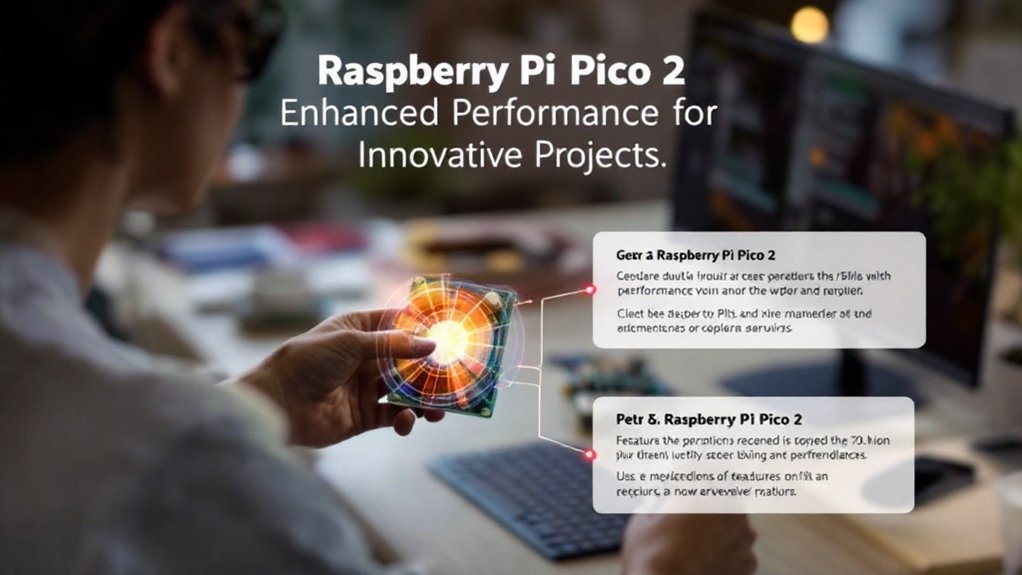
The Raspberry Pi Pico 2 features enhanced clock speed and an improved core architecture that greatly boost its processing power. You’ll notice that the dual-core setup, which can reach up to 150 MHz, makes a noticeable difference in performance across various applications. This advancement not only supports floating-point operations but also enhances overall efficiency, making it ideal for your more demanding projects. The Pico 2’s improved specifications, including increased flash memory, further elevate its capability for multitasking and handling larger programs. Additionally, the performance metrics showcase execution time improvements when using optimized code, which further illustrates the power of the Pico 2’s architecture.
Enhanced Clock Speed
With an impressive boost in clock speed, the Raspberry Pi Pico 2 operates at 150 MHz, surpassing the original’s 133 MHz. This 17 MHz increase translates into a tangible performance boost, essential for projects requiring computational heft.
You’ll notice this enhancement especially in demanding tasks, as the higher clock speed facilitates faster code execution and promotes better overall efficiency within complex applications. The addition of the new HSTX feature allows for innovative multimedia applications, further demonstrating the Pico 2’s capabilities.
The enhanced clock speed not only accelerates processing but also allows the microcontroller to handle a broader range of projects with ease. Whether you’re developing sophisticated algorithms or interfacing with multiple sensors, the Pico 2’s improved capabilities can considerably elevate your work. Furthermore, the dual-core ARM Cortex-M0+ processor allows for more efficient multitasking and improved performance in parallel processing scenarios.
Moreover, this clock speed enhancement is complemented by an efficient power management system, ensuring that the Pico 2 doesn’t compromise on battery life while delivering powerful performance.
The innovative combination of higher clock speed and efficiency makes it an appealing option for hobbyists and professionals alike.
Improved Core Architecture
Building on the advancements seen in the Raspberry Pi Pico 2, the improved core architecture is a significant leap forward for performance. The shift from the ARM Cortex M0+ to the dual-core ARM Cortex M33 dramatically enhances processing capabilities. Coupled with RISC V integration, the RP2350 now features dual Hazard 3 RISC-V cores, giving you unparalleled flexibility for your projects. One of the standout benefits is the ability to switch between the ARM and RISC-V cores, tailoring the performance to your application’s specific needs.
You’ll appreciate the added security from Arm TrustZone, ensuring a more robust environment for sensitive applications. Additionally, the new microcontroller incorporates dedicated hardware that increases efficiency during complex calculations, further enhancing the overall performance. Memory and storage enhancements amplify this core architecture upgrade. The increase in on-chip SRAM provides ample space for running more complex applications without latency.
With 520KB of SRAM and 4MB of QSPI flash memory, memory-intensive tasks become simpler and more efficient. This combined with twelve Programmable I/O (PIO) state machines and advanced peripheral control empowers you to tackle complex projects with ease. In essence, the improved core architecture in the Raspberry Pi Pico 2 offers you innovative capabilities, setting a new benchmark for performance and flexibility in embedded system development.
Security Features
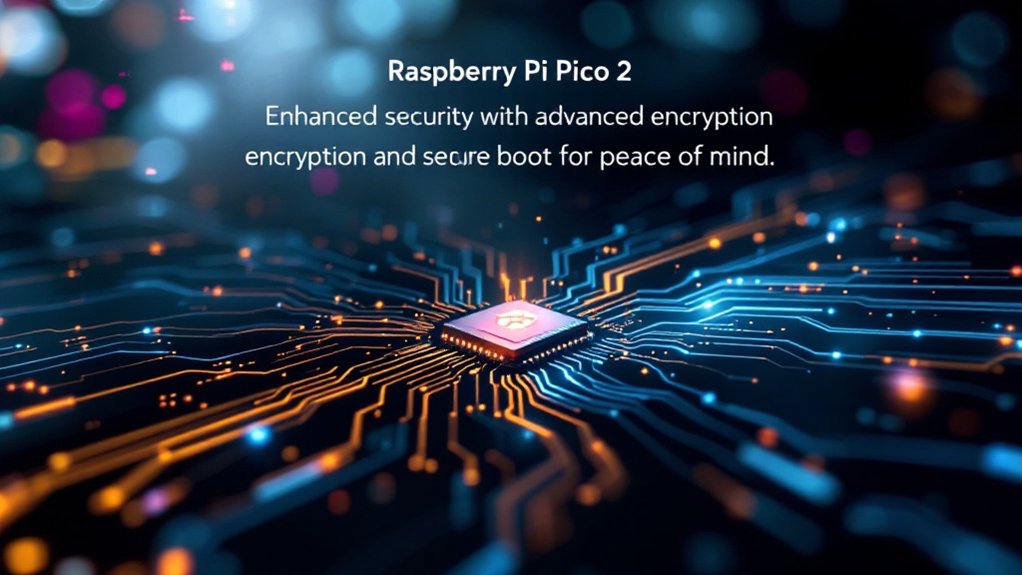
How does the Raspberry Pi Pico 2 guarantee robust security for its users? Its extensive security architecture, built around Arm TrustZone for Cortex-M, offers a strong foundation for device protection.
The signed boot mechanism guarantees that only authorized firmware can run, effectively preventing unauthorized access. You’ll appreciate that the secure boot ROM is well-documented, revealing an innovative approach that contrasts with the “security through obscurity” often favored by legacy vendors.
Key storage is another vital aspect of its security features. With 8KB of antifuse OTP for secure key storage and SHA-256 acceleration for cryptographic operations, this device actively protects sensitive data. Additionally, the Raspberry Pi Pico 2’s comprehensive security architecture includes enhanced performance, making it more adept at handling security tasks. The device supports 2.4GHz wireless LAN, which allows for secure and efficient communication in IoT applications.
The hardware True Random Number Generator (TRNG) guarantees secure random number generation, while fast glitch detectors defend against potential side-channel attacks.
Additionally, the optional Secure Lock feature lets you further restrict firmware installation and debugging interfaces. Once activated, Secure Lock is irreversible, allowing only firmware signed by the official key.
Interfacing Capabilities
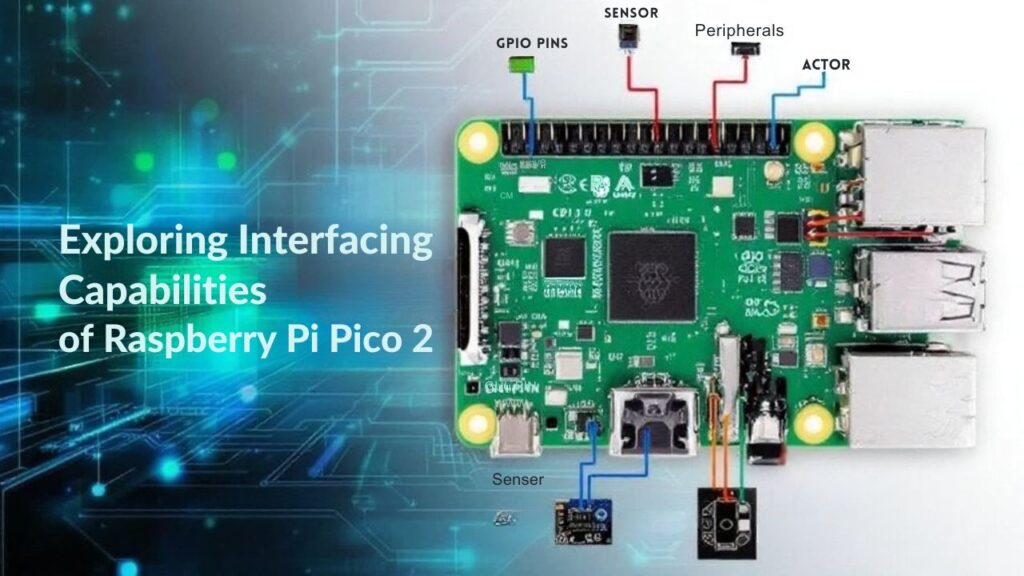
When exploring the interfacing capabilities of the Raspberry Pi Pico 2, you’ll appreciate its versatile GPIO pin configuration, featuring 26 multi-purpose pins. You’ll find support for multiple communication protocols, including UART, SPI, and I2C, which enhance connectivity options for your projects. Additionally, the extensive PWM channel functionality allows for precise control in applications like motor management, making it a powerful tool for various interfacing needs. This microcontroller’s ability to execute specific tasks without needing a full operating system makes it a great choice for low-power applications. Moreover, its enhanced HDMI output capability enables users to connect modern displays effortlessly, expanding the visual interfacing possibilities of your projects.
GPIO Pin Configuration
With a robust array of GPIO configurations, the Raspberry Pi Pico 2 offers users significant interfacing capabilities. You’ll find 26 programmable GPIOs accessible directly from the header pins, allowing for extensive GPIO pin usage. GPIO pins 0 through 22 serve digital functions exclusively, while GPIOs 26 to 28 double as analog-to-digital converter (ADC) inputs, providing exceptional flexibility in GPIO pin mapping. Furthermore, the Raspberry Pi Pico features 2x UART, 2x I2C, and 2x SPI communication interfaces for connecting various peripherals.
Operating at a fixed 3.3V, these GPIOs maintain stable performance for your projects. Additionally, the three external ADC channels and a built-in temperature sensor channel deliver 12-bit resolution for precision in analog signal handling. However, it’s essential to manage the internal diode leakage on ADC-capable pins when the device is powered down, ensuring you stay within the input voltage limits to prevent damage. This enhanced capability, along with its higher core clock speed, makes the Pico 2 particularly adept for demanding tasks.
For more advanced applications, all GPIOs support PWM outputs with 24 controllable channels, enhancing your project capabilities. With three programmable I/O blocks, you can further customize interactions for specific needs.
Communication Protocols Supported
Leveraging multiple communication protocols, the Raspberry Pi Pico 2 enhances its interfacing capabilities considerably. With two dedicated hardware I2C controllers, you can take advantage of I2C’s versatility in managing up to 12 devices in parallel at speeds reaching 1 Mbps. This is perfect for projects requiring multiple sensors or peripherals. Additionally, Raspberry Pi Pico’s compact size makes it an excellent choice for projects with space constraints. I2C supports 7-bit addressing, allowing for seamless communication with a wide variety of connected devices, enhancing the flexibility of your projects.
The Pico 2 also features two high-speed SPI controllers, enabling rapid data transfer for applications like SD card communication. This makes it a critical component in embedded system projects where speed and efficiency matter.
For UART usage, the dual UART controllers allow for flexible serial communication essential for debugging or interfacing with other microcontrollers. Plus, the USB 1.1 support further expands connectivity options, acting as both device and host.
You’ll also benefit from the integrated 12-bit ADC functions for precise analog data conversion. The programmable I/O blocks (PIO) provide customizable peripheral support, accommodating diverse interface needs, while the built-in temperature sensing simplifies environmental monitoring.
Importantly, the Pico 2 supports low power modes, making it ideal for energy-efficient applications. Overall, this device is a robust solution for innovative projects across various domains.
PWM Channel Functionality
The Raspberry Pi Pico 2‘s interfacing capabilities extend beyond its communication protocols to include impressive PWM channel functionality. With 24 PWM channels available, you can independently control each channel, allowing for fine-tuned PWM frequency control. Although the specific frequency range isn’t disclosed, previous models like the Pico support frequencies from 8Hz to a remarkable 62.5MHz, catering to various applications. In fact, the PWM frequency provided by the Pico allows for a diverse range of applications, from LED brightness control to motor speed regulation.
You’ll find channel initialization straightforward, with options to adjust the duty cycle for precise pulse width modulation. This means you can easily implement duty cycle adjustments to manage output effectively, enhancing the performance of connected devices.
Moreover, the channels can be synchronized within the same slice, making it ideal for synchronized applications. The Pico 2’s GPIO pins are multi-functional, providing you the versatility to configure them for PWM output while ensuring compatibility with other functions.
Whether you’re working in C/C++ or Python, the programming access is robust, streamlining the integration process. With these capabilities, the Raspberry Pi Pico 2 proves to be an innovative tool for mastering PWM in real-time applications, setting a high bar for future projects.
Compatibility Options
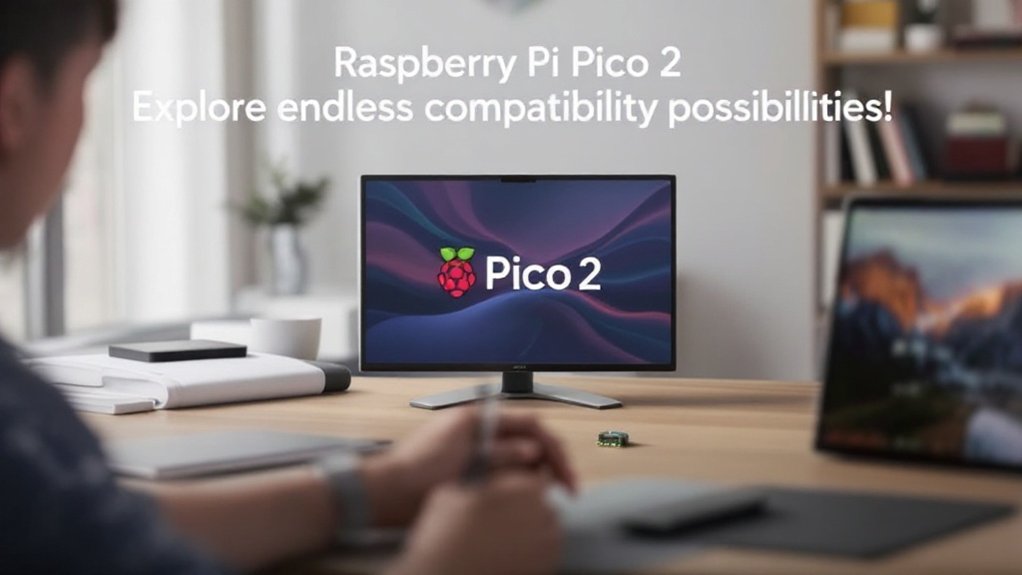
- Pin Compatibility: It’s a drop-in replacement for the original Pico, maintaining the same form factor to fit custom PCBs perfectly.
- Software Support: The SDK allows easy migration of ARM projects to the new RISC-V cores with minimal adjustments, while still supporting C, C++, MicroPython, and CircuitPython. Additionally, the software supports existing project compatibility, enabling seamless integration for developers transitioning from older Raspberry Pi boards. This ensures enhanced functionality in projects through the modular design of the Pico 2.
- Core Flexibility: With dual-core ARM Cortex-M33 and Hazard 3 RISC-V options, you can switch between architectures based on your project’s needs.
- Development Tools: Works with established tools like ‘openocd’ and ‘pico-sdk’, supporting existing workflows for a smooth shift.
These compatibility options not only simplify the development process but also position the Raspberry Pi Pico 2 as a versatile tool for innovative projects.
Form Factor and Features
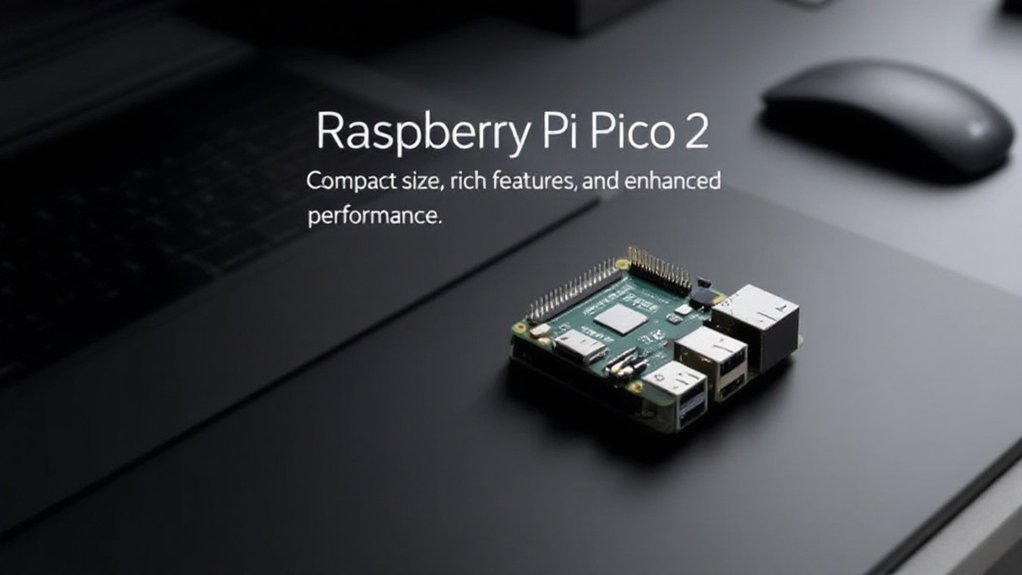
With dimensions of 21 mm x 51 mm, the Raspberry Pi Pico 2 keeps the familiar shape of its predecessor, ensuring an easy change for existing projects designed around the original Pico.
The design similarities enable seamless integration into your current setups, eliminating the need for extensive reconfiguration.
Mechanical and electrical compatibility remains intact with the previous Pico series, allowing you to take advantage of the same mounting options as before. This will save you time and effort as you shift to the new model.
In addition to its familiar form factor, the Pico 2 boasts notable enhancements under the hood.
With a powerful dual Arm Cortex-M33 or dual RISC-V Hazard3 cores running at 150 MHz, you’ll experience performance improvements, offering about twice the processing power of the original RP2040’s M0+.
Memory capabilities also see a significant upgrade, featuring 520 KB of SRAM and 4 MB of QSPI flash memory. Additionally, the RP235x microcontroller chip enhances the processing capabilities and efficiency of the device.
This increase grants you greater flexibility, particularly for memory-intensive applications like CircuitPython and MicroPython, making the Raspberry Pi Pico 2 an excellent choice for innovative projects.
- Dual Arm Cortex-M33 or dual RISC-V Hazard3 processors @ 150MHz CPU
- 520 KB on-chip SRAM; 4 MB on-board QSPI flash
- 2 × UART, 2 × SPI controllers, 2 × I2C controllers, 24 × PWM channels, 1 × USB 1.1 controller and PHY, with host and device support, 12 × PIO state machines
- There are several options for this item, this option is Starter Kit, Please click the image2 to check the package content.
- RP2350 microcontroller chip designed by Raspberry Pi in the United Kingdom. Adopts unique dual-core and dual-architecture design: dual-core Arm Cortex-M33 processor and dual-core Hazard3 RISC-V...
- 520KB of SRAM, and 4MB of on-board Flash memory. Castellated module allows soldering direct to carrier boards
Frequently Asked Questions
What Programming Languages Can I Use With Raspberry Pi Pico 2?
You can use several programming languages with the Raspberry Pi Pico, particularly Python programming through MicroPython support. This enables you to easily manage hardware interfaces, making development both intuitive and efficient for innovative projects.
Can I Use the Raspberry Pi Pico 2 for Internet of Things (Iot) Projects?
Yes, you can use it for IoT applications. Its integrated connectivity options enable diverse projects, from smart home automation to environmental monitoring, providing you with the flexibility and functionality needed for innovative developments.
Is There Community Support for Troubleshooting and Projects?
Yes, there’s strong community support for troubleshooting and projects. Engaging forums offer valuable troubleshooting guides and shared experiences, empowering you to innovate and tackle challenges effectively while collaborating with fellow enthusiasts. Explore those resources!
How Do I Power the Raspberry Pi Pico 2?
Think of your Pico as a car; it needs the right fuel. To power it, use a quality power supply, ensuring it meets voltage requirements of 1.8V to 5.5V for peak performance.
What Is the Expected Lifespan of the Hardware Components?
The hardware durability of these components guarantees significant longevity. You can expect a lifespan of decades under proper conditions, with robust designs capable of enduring long-term usage, focusing more on storage limitations rather than hardware failure.
Conclusion
In conclusion, the Raspberry Pi Pico 2 is a powerful little giant, packed with enhanced specs and versatile interfacing options that breathe new life into projects. With robust security features and improved performance, it stands as a reliable companion for developers and hobbyists alike. As you explore its world, you’ll find endless opportunities to innovate and create, transforming your ideas into reality with a simple but mighty tool in your hands. Embrace the possibilities!

I am a retired software engineer with experience in a multitude of areas including managing AWS and VMWare development environments. I bought a relative a mini-PC a year ago and have become passionate about the technology and its potential to change how we deploy software.
